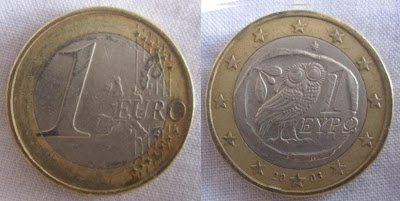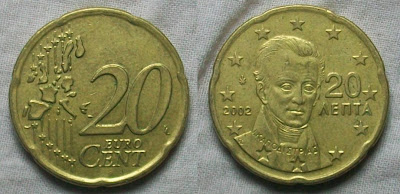Greek 1 euro, 2003
In ancient Greece, owls were often seen as a symbol of good fortune. The idea of the 'wise old owl' may have come into being from the association of the Little Owl with the Greek goddess of wisdom, Athene.
The owl symbolises the goddess Athena and was used for the first time on the Greek 4 drachm or the tetradrachm in the 5th century BC. Athena was patron of the crafts, wisdom and battle. She became the patron goddess of the city of Athens, in a competition with Poseidon. A fascimile of the ancient Greek tetradrachm is shown on the Greek 1 Euro coin shown above.
The owl symbolises the goddess Athena and was used for the first time on the Greek 4 drachm or the tetradrachm in the 5th century BC. Athena was patron of the crafts, wisdom and battle. She became the patron goddess of the city of Athens, in a competition with Poseidon. A fascimile of the ancient Greek tetradrachm is shown on the Greek 1 Euro coin shown above.
Greek Tetradrachm showing owl
Greece 2 Euro
Europa on Zeus
Rembrandt's abduction of Europa by Zeus
Europa was a Levantine woman in Greek mythology, from whom the name of the continent Europe was ultimately taken. There were two competing myths relating how Europa came into the Greek world: in the more familiar one she was seduced by the god Zeus in the form of a bull and carried away to Crete on his back, but according to Herodotus she was kidnapped by Minoans, who likewise were said to have taken her to Crete. The mythical Europa cannot be separated from the mythology of the sacred bull, which had been worshipped in the Levant. The etymology of her name suggests that Europa represented a cow, at least at some symbolic level.
The painter Rembrandt Harmenszoon van Rijn created an artwork tilted the Abduction of Europa, which represents the ancient Roman poet Ovids story about the god Jupiter seducing a princess called Europa. This Roman tale was known as The Abduction of Europa and also known as The Seduction of Europa, substituting the god Jupiter for Zeus. Edith Hamilton's Mythology says Zeus, the son of Cronus, overthrew his father to free his five siblings and rule the gods. He is the most powerful of all the gods. Yet he is not invincible. According to Ovid's The Metamorphosis Zeus's father Cronus calls his son aside and asks him 'Son, faithful worker of my commands, go, quickly in your usual way, fly down to where, in an eastern land, they observe your mother's star, among the Pleiads. There drive the group of royal cattle, that you will see some distance off, browsing the mountain grass, towards the sea shore!' Zeus immediately leaves and takes the shape of a bull, a bull that was snow white. His eyes were unthreatening. Europa dared to sit on the bull's back. The god slowly moved from offshore to the shoreline and gradually goes further out to sea. Europa became the first queen of Crete, and she gives birth to a hero, King Minos of Crete.
Greece 2 Euro , Athens olympics 2004
This one is a commemorative 2 euro coin released when Athens hosted the Olympics in 2004. The figure is taken from Myron's Discobolus statue representing the olympic history from ancient greece.
Myron's Discobolus statue
- The Discobolus statue olympic discus thrower was made by Myron, one of the best sculptors of ancient Greece who lived in Athens in the 5th century BC. The original Discobolus statue was never recovered, an exact copy of the statue however is placed at the entrance of the Panathinaikon Stadium in Athens, where the first modern Olympic Games were held in 1896 AD. Considered by many to represent the perfect athletic form, Discobolos, this Grecian work of art is renowned for its contribution to the contrapositive form of sculpture. Myron's Discus Thrower is one of the most famous classic Greek statues from this period. Discobolus athlete engaged in the discus throw boastful vigorous and convincing movement in a perfect made form. His flexing muscles and concentrated expression create a strong impression.
The name of each Olympiad was named after the competitor of the stadium race, which was the favourite of all the events. The first Olympiad was named Koroibos of Elias, as he was the winner of the stadium race in 776 BC.
Olympia was, and still is, a beautiful place, and many temples and statues were built. These were all built in dedication to Zeus, the Father of all Gods. Olympia also became a centre for religion in the Mycenaean period.
The temples that were built in Olympia were all for a reason, and were of importance. The temple of Zeus, had as its centrepiece, a gold and ivory statue of Zeus. Standing at about 12 meters in height, the statue was very impressive.
The statue, sculptured by Phidias, was seen as one of the seven wonders of the ancient world. Also near to the temple of Zeus, was the wild olive tree from which the wreath crowns were made and presented to the winners of the events. Legend has it, this tree was planted by Herakles (Hercules).
In the beginning, the games consisted of only one event, the running of the stadium, and lasted for just one day. However, towards the 5th century, the games were extended to five days, and more events were also added.
From 729 BC the participants of the games had to compete in the nude in order to prevent any cheating, and also in the interest of safety. Originally, only Greeks born males, who had not committed murder or heresy, where allowed to take part in the games. However, later on, Romans were also permitted to take part. Women were forbidden to compete, and were even banned from entering the stadium to watch the games.











